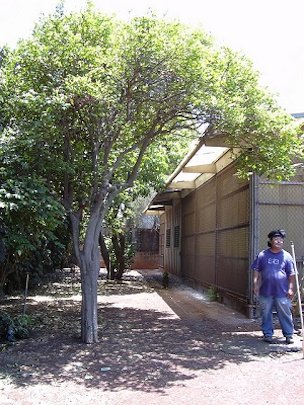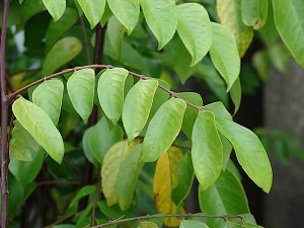Publication
from Agroforestree Database: a tree reference and selection guide
version 4.0
by C. Orwa, A. Mutua, R. Kindt, R. Jamnadass and S. Anthony
Averrhoa
carambola L.
Local Names:
Creole (blinblin
long, ziblinn long, karambola, kònichon peyi); English (foreign
peach, carambola, five corners, star pickle, star fruit); Filipino
(balimbing); French (cornichon du pays, blinblin
longue, carambolier, carambolier vrai); German (Karambolaßaum);
Hindi (kamrakh, kamranga); Indonesian (belimbing manis); Khmer
(spö); Lao (Sino-Tibetan) (füang); Malay (belimbing manis);
Mandarin (yongt’o); Spanish
(carambole, carambolo, carambold, jalea, carambola); Swahili (mbirimbi wa
kizungu); Thai (ma fueang); Vietnamese (khê)
Family:
Averrhoaceae
Botanic
Description
Averrhoa
carambola is a
small, evergreen, multistemmed tree 3-5 m high or rarely 10 m high,
attaining 15 cm diameter at the base; bark light brown, smooth or
finely fissured.
Leaves alternate, pinnate, 15-25 cm long,
disposed more or less in a horizontal plane, shortly petiolate with 7-9
pendant leaflets; leaves have the peculiarity of being sensitive to
touch in the same way as certain Mimosa
species.
Inflorescence
in panicles 2-5 cm long in the axils of old leaves; flowers
pentamerous, with a calyx of 5 pink sepals surrounding the purple
corolla; androecium contains 5 fertile stamens and 5 staminoids;
gynoecium bears 5 slender united styles.
Fruit a large,
indehiscent berry, 5-8 cm long; with a characteristic shape in
cross-section resembling a 5-pointed star; yellowish-green, becoming
orange-yellow when ripe. Each cell of the fruit contains 5 arillate
seeds.
The generic name is after Averrhoes (1126-98), the widely
known Arab Philosopher. The specific name, ‘carambola’, is
said to have come from Malabar and was adopted early by the Portuguese.

Habit at State nursery Kahului, Hawai'i

Leaves at State nursery Kahului, Maui,
Hawai'i (Forest and Kim Starr)
Biology
Heterostyly and self-incompatibility occur in A. carambola.
Pollen grains are elongated or spherical; a suitable pollen viability
test would be in vitro pollen germination. A. carambola is insect
pollinated, the pollinators being honeybees and Diptera
species. Flowering continues throughout the year and fruit is available
most of the year. Seedling varieties should crop in 3- 8 years,
selected grafted varieties in only 1-2 years.
Ecology
Grows
best in the hot, humid tropics but will tolerate some cool weather.
Young plants may be killed or badly damaged by frost, while mature
specimens can withstand temperatures as low as -3 deg. C for short
periods, with some damage to branches and leaves. They can also
tolerate dry periods and some wind if it is not too cold.
Biophysical
Limits
Altitude: 0-900 m
Temperature: 20-35 deg. C
Rainfall: annual 1800 mm
Soil type: Prefers deep, well-drained clay loams but can grow
successfully on sandy soils and heavy clays.
Documented
Species Distribution
Exotic: Australia, Brazil, Cambodia,
China, Colombia, Dominican Republic, India, Israel, Japan, Laos,
Myanmar, Philippines, Singapore, Taiwan, Province of China, Thailand,
Trinidad and Tobago, Uganda, US, Vietnam
Native: Indonesia, Malaysia

The
map above shows countries where the species has been planted. It does
neither suggest that the species can be planted in every ecological
zone within that country, nor that the species can not be planted in
other countries than those depicted. Since some tree species are
invasive, you need to follow biosafety procedures that apply to your
planting site.
Products
Food:
Fruits are refreshing eaten fresh, mixed with other fruits, in salads,
or processed into drinks. They are also stewed, pickled or used for
chutney and jam. The fruit flavour is enhanced by peeling off the
‘wing’ edges, which removes most of the oxalic acid.
Because the fruit is extremely perishable it must be consumed locally.
Some Brazilian cultivars have a very high content of vitamin C as well
as an applicable amount of provitamin A.
Fuel: The wood is a suitable candidate for firewood.
Timber: The soft, whitish wood is sometimes used for timber.
Tannin/dyestuff: Unripe fruit of A.
carambola contains potassium oxalate, which is used in
dyeing.
Medicine:
Fruit can be a laxative on account of the oxalic acid it contains. It
is also used in traditional medicine for skin disorders and fevers.
Other products: In some countries, the fruit juice is used to remove
stains, for example iron rust from linen cloth.
Services
Ornamental: With its delicate, light-green foliage, small, pink flowers
and prolific golden-yellow fruits, A.
carambola is popular in homegardens and parks.
Tree
Management
When young, A. carambola
is delicate and requires careful attention. Because it is a
fast-growing tree, it requires pruning and thinning of excess fruit at
an early stage. Good crops are harvested from grafted varieties when
they are 2- 3 years old. Yields of up to 900 kg/year are common for
10-year-old trees.
Germplasm
Management
Seed
storage behaviour is intermediate. The lowest safe mc is 12.3%; further
desiccation reduces viability. Cool temperatures damage the seeds.
Viability can be maintained for 6 months with partially dried seeds at
5 deg. C. There are approximately 15 000 seeds/kg.
Pests and
Diseases
Caterpillars (Diacotrichia,
Pingasa and Pseudoterpna) attack the flowers and young
leaves. A. carambola
fruit suffers from fruit fly maggots, particularly Dacus dorsalis
(Southeast Asia), and fruit-piercing moth (Othreis spp.,
Australia); bagging prevents infestation. Leaf spot (Cercospora averrhoa)
and pink diseases (Corticium) affect the tree in Southeast Asia, but
postharvest rots are more serious: the slightest blemish invites
infection by Ceratocystis,
Colletotrichum, Dothoriella and Phomopsis fungi.
Further
Reading
Anon. 1986. The useful plants of India. Publications &
Information Directorate, CSIR, New Delhi, India.
Crane E, Walker P. 1984. Pollination directory for world crops.
International Bee Research Association, London, UK.
FAO. 1982. Fruit-bearing forest trees: technical notes.
FAO-Forestry-Paper. No. 34. 177 pp.
Hong TD, Linington S, Ellis RH. 1996. Seed storage behaviour: a
compendium. Handbooks for Genebanks: No. 4.
IPGRI.
Katende AB et al. 1995. Useful trees and shrubs for Uganda.
Identification, Propagation and Management for Agricultural and Pastoral Communities. Regional Soil Conservation Unit
(RSCU), Swedish International Development Authority (SIDA).
Nicholson B.E, Harrison S.G, Masefield G.B & Wallis M. 1969.
The Oxford Book of Food Plants. Oxford University Press.
Perry LM. 1980. Medicinal plants of East and South East Asia:
attributed properties and uses. MIT Press. South East Asia.
Popenoe W. 1974. Manual of the tropical and subtropical fruits. The
Macmillann Company.
Rice RP, Rice LW, Tindall HD. 1987. Fruit and vegetable production in
warm climates. Macmillan Press, London.
Sedgley M, Griffin AR. 1989. Sexual reproduction of tree crops.
Academic Press. London.
Tankard G. 1987. Tropical fruit. A guide to growing and using exotic
fruits. Viking O’Neil.
Timyan J. 1996. Bwa Yo: important trees of Haiti. South-East Consortium
for International Development. WashingtonD.C.
Verheij EWM, Coronel RE (eds.). 1991. Plant Resources of South East
Asia No 2. Edible fruits and nuts. Backhuys Publishers, Leiden.
Williams R.O & OBE. 1949. The useful and ornamental plants in
Zanzibar and Pemba. Zanzibar Protectorate.
|
|

